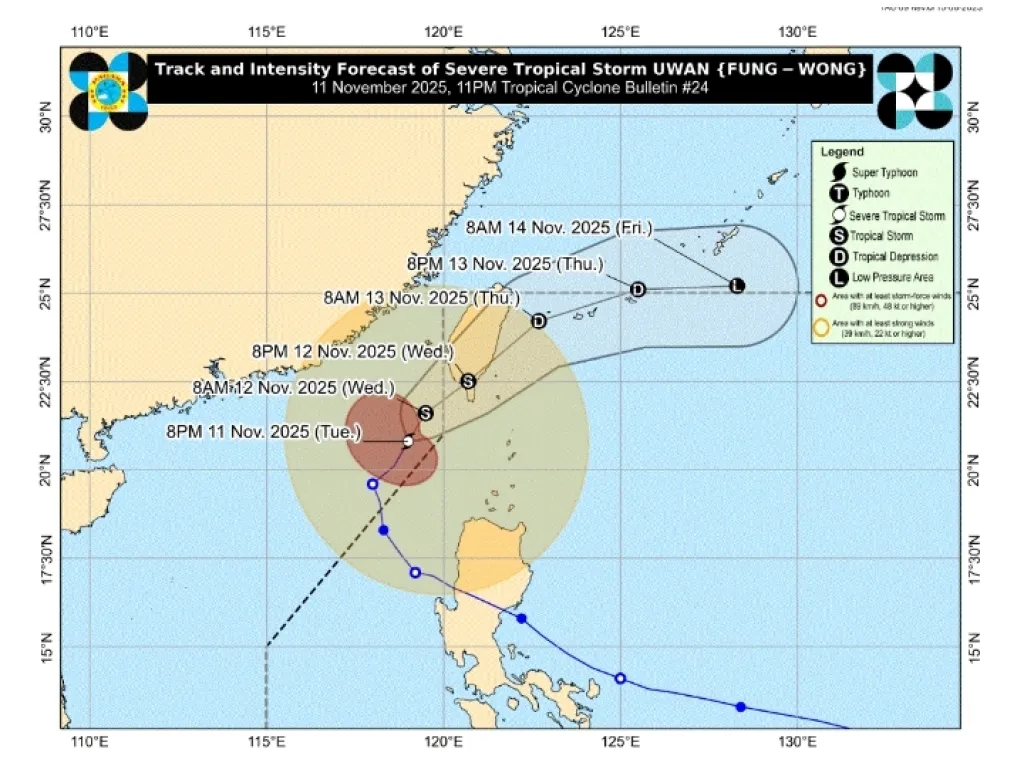Our favourite places to stay on this sleepy Cebu island.
Travelling After Typhoon Uwan May Re Enter PAR, What You Need to Know

Typhoon Uwan has exited the Philippine Area of Responsibility (PAR), but it may re enter PAR by Wednesday afternoon (12 November 2025) according to PAGASA. This possible re entry is due to Uwan’s curved track near Taiwan, which could bring its circulation back into the country’s monitoring zone. Although the typhoon has weakened into a tropical storm, its wide rainbands could still bring rain and strong winds to parts of Northern Luzon, particularly in coastal and mountainous areas. Travellers should stay alert, monitor weather advisories, and be cautious when heading north.
Northern Luzon is still recovering. Many towns are clearing debris and restoring electricity, but not all destinations are ready for visitors. Typhoon Uwan caused intense rainfall, flooding, and landslides, leaving roads in Cagayan, Isabela, and the Cordillera region damaged. Over three million households remain without power.
Most major airports such as Manila and Clark are back to normal, but flights to Tuguegarao, Laoag, and Basco may face delays. Highways in Northern Luzon are partially closed because of landslides and damaged bridges, so road trips to Baguio or mountain destinations may take longer. Check bus updates or local advisories before travelling.
Some ferry services in northern ports like Aparri and Currimao are still suspended while conditions are assessed. Baguio and La Union are slowly welcoming visitors again, but several riverside resorts in Cagayan and beaches in Ilocos are still undergoing cleanup.
For safer travel, consider Central or Southern Luzon where roads and utilities are more stable. Pampanga, Bulacan, Zambales, Batangas, and Cavite were less affected and remain open. Supporting small local businesses in these areas helps communities recover.
Rebuilding, Responsible Travel, and Moving Forward

Image credit: DOST-PAGASA | Facebook page
Filipinos are actively repairing bridges, clearing roads, and running donation drives. Travellers can help by supporting local cafés, hostels, and shops reopening after the storm.
If visiting affected areas, pack responsibly. Bring bottled water, power banks, and cash, and consider small relief items like canned food or toiletries for local residents still in need.
Typhoon Uwan’s possible re entry into PAR is a reminder that conditions can change quickly. Stay updated with PAGASA and local authorities to travel safely.
Travelling responsibly means being aware and sensitive to the needs of recovering communities. Every visit helps local areas bounce back faster. Check the latest updates and choose destinations that are ready. Travelling after a storm is not just about seeing new places; it is about standing with the people who keep the spirit of travel alive.
Published at
About Author
Jeliefer Sumaya
Subscribe our Newsletter
Get our weekly tips and travel news!
Recommended Articles
10 Bantayan Island Resorts, Hotels, and Rentals for Your Tropical Escape 10 Best Mountain Cafes in the Philippines for Your Peak Coffee Experience Coffee date on the mountains, anyone?
10 Best Things to Do in Los Angeles Los Angeles is more than Hollywood stars. From hikes with killer views to beaches straight out of a rom-com, here are 10 must-do LA experiences for Filipino travellers or any wanderers in general!
10-day Christmas and New Year Japan Trip: Complete Travel Itinerary Celebrate Christmas and New Year in Japan with this 10-day holiday vacation itinerary packed with Tokyo lights, Kyoto charm, and Osaka adventures.
10 Family Outing Ideas in Metro Manila Under ₱500 Looking for a weekend bonding with the family under ₱500? Head to these places, pronto!
Latest Articles
Nadine Lustre Vibes, Sierra Madre, Luzon’s Guardian Mountains Adventure and nature combined
Buntun Bridge in Tuguegarao Closed Due to Rising Water Levels Bridge closed amid high waters
After Surviving Typhoon Tino, These Are the Things I’m Glad I Packed Essential typhoon travel items
What Makes Sierra Madre So Special?: Luzon’s Backbone and Shield From Typhoons Sierra Madre saves lives, wildlife, and farmland. Are we letting it disappear?
How to Help Typhoon Kalmaegi (Tino) and Typhoon Fung-wong (Uwan) Victims and Avoid Donation Scams List of legitimate donation drives to the victims of Typhoon Kalmaegi and Fung-Wong

